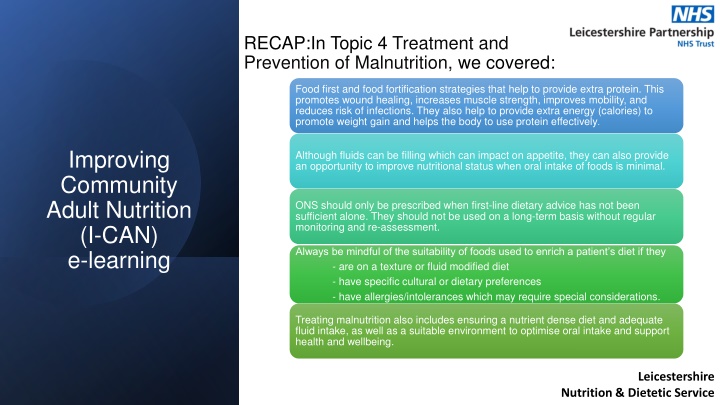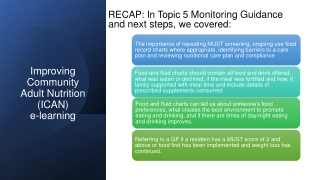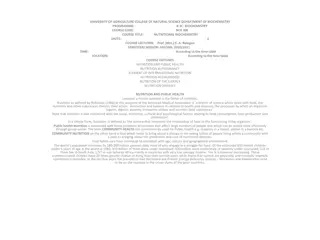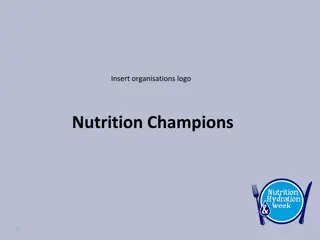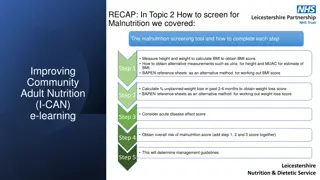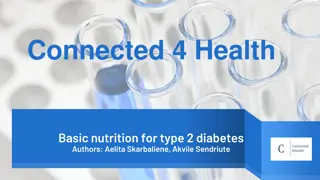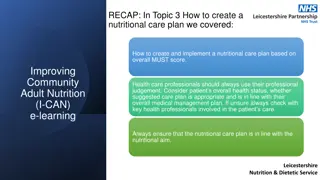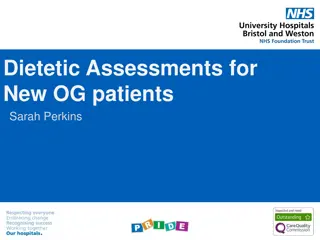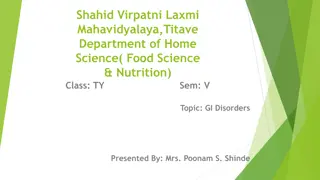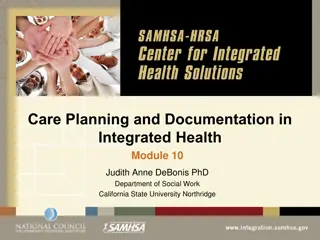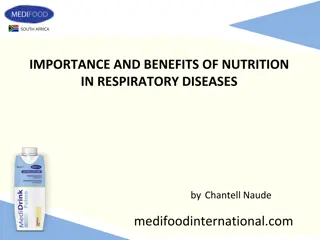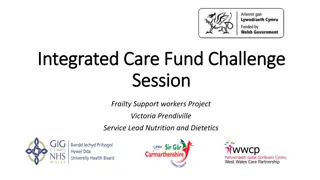Manage Nutritional Care Plans Effectively: Monitoring and Strategies
Explore the key strategies for treating and preventing malnutrition, including food fortification and energy promotion. Learn about tools like food and fluid record charts, along with monitoring guidance for effective patient care. Understand the importance of consistent monitoring and addressing potential barriers to enhancing nutritional status and overall well-being.
Download Presentation

Please find below an Image/Link to download the presentation.
The content on the website is provided AS IS for your information and personal use only. It may not be sold, licensed, or shared on other websites without obtaining consent from the author.If you encounter any issues during the download, it is possible that the publisher has removed the file from their server.
You are allowed to download the files provided on this website for personal or commercial use, subject to the condition that they are used lawfully. All files are the property of their respective owners.
The content on the website is provided AS IS for your information and personal use only. It may not be sold, licensed, or shared on other websites without obtaining consent from the author.
E N D
Presentation Transcript
RECAP:In Topic 4 Treatment and Prevention of Malnutrition, we covered: Food first and food fortification strategies that help to provide extra protein. This promotes wound healing, increases muscle strength, improves mobility, and reduces risk of infections. They also help to provide extra energy (calories) to promote weight gain and helps the body to use protein effectively. Improving Community Adult Nutrition (I-CAN) e-learning Although fluids can be filling which can impact on appetite, they can also provide an opportunity to improve nutritional status when oral intake of foods is minimal. ONS should only be prescribed when first-line dietary advice has not been sufficient alone. They should not be used on a long-term basis without regular monitoring and re-assessment. Always be mindful of the suitability of foods used to enrich a patient s diet if they - are on a texture or fluid modified diet - have specific cultural or dietary preferences - have allergies/intolerances which may require special considerations. Treating malnutrition also includes ensuring a nutrient dense diet and adequate fluid intake, as well as a suitable environment to optimise oral intake and support health and wellbeing. Leicestershire Nutrition & Dietetic Service
I-CAN Monitoring Guidance and Next Steps Please DO NOT save or share this PowerPoint to avoid circulation of out of date information
Aims: Understand what factors to monitor in line with patient s nutritional care plan Learn how to adequately complete food and fluid charts Learn how to evaluate information obtained when reviewing nutritional care plan and what actions to take next
Monitoring: Once the MUST management plan is in place, it is important to continue to monitor the patient. Below are key factors to monitor: Repeat MUST screening as required Review of nutritional care plan and compliance Review food & fluid charts Identify potential barriers that may affect the care plan put in place- e.g. poor skin integrity, environment, infection status, mood, bowels Ensure record keeping is timely and accurate If eating - all portions of all meals and puddings, discontinue food record charts and recommence if concerns over oral intake
These can be used as a tool to clearly show what a patient has eaten and drank over a period of time and how much has been consumed. Food and Fluid record charts It should be used for management plan of MUST score 1 and above. What should it include? All food and drinks offered throughout the day Amount taken/declined i.e. (eaten half of main and all dessert) Any additional fortification added to food or drinks (i.e. fortified with dried skimmed milk powder and 2 tablespoons of double cream) Foods brought by family/relatives or eating out Any prescribed oral nutritional supplements. These will also be included on the medication charts
What can food and fluid record charts tell us? Helps to identify window of opportunity on when to maximise nutritional intake e.g. preferred time of day Helps to identify food preferences and trends with food intake e.g. eating patterns May guide on best environment for patient on where they eat best e.g. food charts show patient eats better at lunch which is usually eaten in the dining room with others, therefore additional meals could be encouraged in the dining room Aids communication between staff, relatives and health care professionals as it provides documented summary of oral intake
Evaluate what to do next? If you have identified areas of concern when monitoring management plan in place, please consider the following next steps: Act Act on results- e.g. increased MUST score Inform Inform senior staff Change nutritional care plan- e.g. consider food first/food fortification strategies Change Refer to a GP if meets referral criteria or contact dietitian if already involved Refer
Food first/food fortification have been implemented however weight loss continues and/or MUST score increased to 2 or above Consider referral to a GP if: Please note: If patient is already under a dietitian, contact dietitian directly
Monitoring guidance Repeat MUST screening- Has MUST score changed? Review of nutritional care plan- Is the current plan still appropriate? Knowledge check: Ethel has now recovered from her chest infection and recent food and fluid charts (commenced when her MUST score was 2) suggest that she is eating more than of most meals and as a result she has gained 2kgs. What would you monitor and evaluate? Review food & fluid charts- Does this need to continue? Identify potential barriers- Reflect on changes made to overcome any potential barriers and how might these strategies be used in the future Evaluation guidance As Ethel is eating well and weight is increased, food charts could be stopped and nutritional management plan going forward should be inline with updated MUST score
Summary The next PowerPoint will now cover key additional factors which support and influence meeting patients nutritional care needs. The PowerPoint will include topics such as hydration, skin health, oral health/dentition, allergies and bowel health. It will also provide information on useful links that can be accessed to support those you care for.
